Next Thursday, assuming I can keep the panic attacks at bay, I’ll be conducting live exit interviews in front of a raucous, beer-swilling crowd at Conor O’Neills, as part of Concentrate Media’s moderately-distinguished speaker series. (It’s free, and open to the public, but, if you’d like to attend, you need to register in advance.) Here, in preparation for the big event, is one more entry in the ever-swelling Exit Interview Archive. Tonight’s subject is Indian-born, Canadian expatriate Vikram Bastian. Vikram, who recently moved to Oakland, California, was kind enough to respond to all of my questions, save for one… the one that I most wanted answered. So, I have a favor to ask of those of you who are reading this in San Francisco Bay area. If you should happen to bump into Vikram, do me a favor – take out your flip camera, and get video of yourself asking him the following… “Which of the kids on Degrassi Street do you most identify with?” (It’s a question that I feel needs to be asked of all Canadians.) If you post video online, and send me a link, I’ll add it here, and send you $2 for your troubles… Now, here’s the interview. Enjoy!
do you most identify with?” (It’s a question that I feel needs to be asked of all Canadians.) If you post video online, and send me a link, I’ll add it here, and send you $2 for your troubles… Now, here’s the interview. Enjoy!
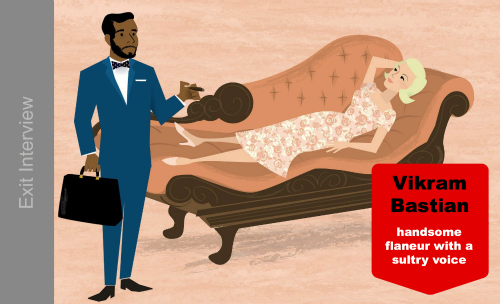
MARK: I pride myself in being fairly good at spotting Canadians, but, in your case, I didn’t catch it… which makes me think that you consciously work to keep that side of yourself hidden? I am, of course, basing this “Canadian shame” theory of mine on just the two short face-to-face onversations that we’ve had… So, do you purposefully strive to hide your Canadianness? And, if so, why?
VIKRAM: “Canadian shame” has a nice ring to it, Mark. It think could have two meanings, though. One would refer to our shaming of Americans, as we love to make fun of the ridiculous notion of American exceptionalism. The other would refer to the Americans’ ridicule of Canadian exceptionalism. And, by that, I mean our exceptional socialism. I guess you’re talking aboot the latter, eh?
Michigan is pretty homogenous, and, being a Canadian, and an undocumented resident (I prefer not to refer to myself as “illegal”), it wasn’t something that I wanted to share publicly during those xenophobic Bush years. I was also bullied a lot after I moved to Canada. It’s hard enough being a brown geek, that I didn’t like being the butt of Canadian or “illegal immigrant” jokes. It became something of a habit then, to hide my Canadianness. Assimilation was survival in a sense.
Imagine the confusion too – a Canadian smuggles himself across the Detroit River in order to escape crushing social health-care, affordable education and affluence?
People don’t understand that Canada is lot more like the U.S. than it is different… minus the guns. At this point, I consider myself as much American, as I am Canadian, as I am Indian.
MARK: What brought you, at the age of 25, to Ann Arbor?
VIKRAM: I was a broke university dropout, living in my parents’ basement and working blue collar bank jobs. I was pretty miserable, and felt there was a veil over Canadians – hockey, new cars, new housing, flat screens, cell-phones, chain restaurants, and so on… I remember watching Manufacturing Consent – Noam Chomsky and the Media in 2005, and half of the archival footage used was of Mississauga, Ontario, the premiere Canadian suburb. I left Canada on my 25th birthday after an argument with my parents over a haircut. I had $400 to my name, and moved in with my then girlfriend, who was studying at the University of Michigan. I was just trying to get as far away from conservative Indian Catholic values as I could, and that haircut changed my life. 4,239km seems about the right distance, even though we get along now.
in 2005, and half of the archival footage used was of Mississauga, Ontario, the premiere Canadian suburb. I left Canada on my 25th birthday after an argument with my parents over a haircut. I had $400 to my name, and moved in with my then girlfriend, who was studying at the University of Michigan. I was just trying to get as far away from conservative Indian Catholic values as I could, and that haircut changed my life. 4,239km seems about the right distance, even though we get along now.
 MARK: I understand wanting to follow your girlfriend, and put some distance between you and your conservative parents, but I’m having a little more trouble with the Chomsky argument. Not many people come to America to escape the things that he speaks of in Manufactured Consent.
MARK: I understand wanting to follow your girlfriend, and put some distance between you and your conservative parents, but I’m having a little more trouble with the Chomsky argument. Not many people come to America to escape the things that he speaks of in Manufactured Consent.
VIKRAM: I can’t say I’ve really thought through many of the big decisions in my life. I had this instinct that America was the heart of darkness, but also enlightenment. So, better than the devil that I knew in suburbia. I still think a lot of enlightened trends originate here, along with a lot of unenlightened ones.
I keep thinking back to this quote by Martin Luther King, about how “the Negro’s great stumbling block in his stride toward freedom is not the White Citizen’s Counciler or the Ku Klux Klanner, but the white moderate, who is more devoted to order than to justice.” In my view, Canadians are that affluent white moderate, and blind to their ways.
There is also just a larger and more legitimate activist and counterculture movement here, and that appealed to me. Oddly, I have a good friend who grew up in Ann Arbor and moved to Vancouver. I’m sure he is never coming back, and I wonder how he feels.
MARK: More importantly, does a photo of the haircut exist?
VIKRAM: Yes.
MARK: Well, can we see it? And, if not, can you at least describe it? I’m fascinated to know more about a hairstyle that has the ability to wreck a family.
VIKRAM: At that time, my parents had been drinking the Kool Aid like everyone else. They are still religiously conservative, but more progressive these days. I’d bucked all the Indian trends, and it was really taxing them. Admittedly, it took me a long time to realize how to cope with my own depression.
I was working at the same office as my Mom, and I got this faux-hawk on the day of my birthday. They were furious because of what my Mom’s bank coworkers would think, and we got into this terrible argument. I’m mostly a pacifist, but I inherited this terrible pride and temper from my Dad. I walked out, and was determined to prove them wrong.
Tragically, my family’s conservative worldview shifted after my Mom was wrongly fired after 13 years of loyal service to this bank, 8 months shy of her retirement. They accused her of stealing $900, which she herself had reported missing. Truthfully, there were two young, haughty, ageist and racist managers who wanted to scare a small, old, brown woman. She took them to court, but, at the end of the day, there’s little justice for a woman of color against a national bank. That indelibly marked our family, and we grew a lot closer at a result…
If I might offer a PSA: Try out a credit union. I still bank with the UofM Credit Union. Big banks really are a terrible thing.
MARK: I’ve heard you describe yourself before as “that ubiquitous brown guy at shows,” and I’m wondering if you might have any thoughts on the inclusiveness, or lack thereof, of the local music scene.
VIKRAM: I use that term because that’s how most people remember me, even years later. It’s true though, I’ve often been the only person of color at a show, and I’m often up front, recording it, or dancing.
I don’t easily group identify – I’m not folk, rockabilly, a metalhead or a punk rocker, and, in that sense, there is an exclusivity in the local music scene. I’ve been invited a fair bit to play shows, though. I personally write and listen to whatever music feels good to me at the time as opposed to a specific genre… Here’s a link to a song about a lady rocker from the mitten that I fell for recently.
Generally, I’d say a lot of the circles I hung out in were very inclusive. Most of my friends were counterculture freaks and geeks, which is an identity I share with them. Brown is just one facet of myself that I identify with. Things seemed different a few years ago, more basement shows, Sunday potlucks, urban gardens and free school happenings. I started the Far House, an experiment in basement shows, dumpstering and chicken coops, so there was an easy inclusivity in the scene. I had wanted to live in an another art & music community, but was denied. I didn’t take that too well, so I started my own community. I’m utterly amazed that the house continues to showcase some of the best music talent around, in a tiny basement.
Inclusiveness in the political scene, well that’s a whole other story.
MARK: Tell me about Far House. How’d it come about? And what kinds of shows did you put together when you were booking? Also, I’m curious as to this other “art & music community” that denied you. Did they explain their reasoning?
VIKRAM: Far House is a small ranch style house in SE Ann Arbor, situated between a bunch of Libertarians and conspiracy nuts. Noise, bonfires and counterculture has never posed a problem, and I don’t think the cops have been called once in the 5 years and the 70+ shows.
The shows range from chiptune to psych rock, but the space certainly isn’t trying to be hip or appeal to anyone in particular. Eric and John do most of the booking and their intent is to mix the lineup. So you’d come to hear electro and get treated to punk rock after. It was meant to be inclusive and has seen a lot of acts, local and national. I remember going to Bitchpork in Chicago last summer, a subversive event that takes place the same time as the big, annual Pitchfork show. Far House had booked a lot of the same acts, and even some better ones.
I was denied residence at the Hotel Midwest initially, and their reasoning was justified. I was too bohemian, and they were looking for active members. I did end up moving in later, after a change of guard. Eventually the founders moved on and a bunch of young punks moved in. They were terrible tenants and got evicted. They had this final party and destroyed everything that my friends had worked hard to build. They torched this 6 foot seesaw, broke a glass greenhouse, and destroyed whatever else they could find. I heard about it a week later, and went by to see if I could salvage the wooden door sign, but they’d burned that too. I think they’d consider themselves anarchists, but I’d consider them asses.
MARK: When did you first venture into Ypsilanti from Ann Arbor, and what were the circumstances? Was it music-related?
VIKRAM: I moved to Ypsilanti in 2011. I was underemployed, and Ypsi offered the right combination of affordable housing, casual work and basement space for music. I prefer Ypsilanti to Ann Arbor in the same way I prefer the East Bay to San Francisco… far less pretense. I ended up back in Ann Arbor to start a job as a web developer – my Indian birthright. Ypsi feels ripe to offer some income tax break to the tech industry, I could see the Water Street Project becoming a tech park. The Ann Arbor politic and DDA seems more focused on the trickle down economy of high rises & underground parking structures.
MARK: Between Ypsi and Arbor, you lived here for 7 years. If you were to map those seven years out on a graph, with the X-axis being time, and the Y-axis being happiness, what would the resulting graph look like?
VIKRAM:I tend to just remember the good parts, but it’s been a roller coaster. I also grew up under an endless tropical sun, so gray winters take a lot out of my soul. California fits my temperament better.
Even though I eventually got above the poverty line, which is considered less than $30K and without benefits, I grew unhappy. Things hit an all time low last winter, and that’s when I committed to leaving the city. I felt it was only a matter of time before something truly regrettable happened.
I should have been really happy, working on Main Street, dating, mingling with young professionals, and going to the Blind Pig regularly. I was actually depressed, though, and self medicated a lot. My life and relationships were part hubris and part sadism, quintessentially American in it’s excess and hedonism. It was a very disturbing time in my life, but strangely normal by Ann Arbor standards.
I think that alcoholic salacious lifestyle stems from having a college and football binge culture at the heart of the City’s identity. I think you can draw the parallels given the recent Steubenville rape case… there’s a toxic masculinity associated with it. Combine that with a lack of opportunity, and you’ve got a great recipe for substance abuse, depression and lost souls. A lot of young men I’ve met struggle with it, few get help, others leave. There isn’t anything glamorous about alcoholism with young folks.
2012 in particular beat the Canadian naiveté right out of me. It impacted me sufficiently that I’ve dropped most of my vices since. I consider 5 beers a lot now, probably since I’d left most of my liver in Ann Arbor. I rarely drink during the week, and I order more sodas. I’ve hung out with a few Washtenaw expats, ones you’ve interviewed before. We seem to have this relative sobriety in common, except maybe when we get together.
Ann Arbor is probably the lushest city I’ve lived in, and I don’t mean the outdoor kind… or maybe I do… never mind.
Still, I’d regrouped enough before leaving, with the love of friends, to make my last summer in Michigan memorable. Shows in Detroit, midwest lakes, bike rides, outdoor fests, friends and such. One Love!
 MARK: You mention being an undocumented worker. I assume that makes life challenging. Could you perhaps speak a bit about how your life might be different from other readers of this site as a result of that, and what resources exist for people like you that are walking the line of legality. (I’m curious, for instance, if people in similar situations find one another, share information, etc.) And is legal residency something that you’d consider?
MARK: You mention being an undocumented worker. I assume that makes life challenging. Could you perhaps speak a bit about how your life might be different from other readers of this site as a result of that, and what resources exist for people like you that are walking the line of legality. (I’m curious, for instance, if people in similar situations find one another, share information, etc.) And is legal residency something that you’d consider?
VIKRAM: Psychologically, it’s unnerving. You have to be careful and aware. You’re forced to live in the here and now. There were a few close calls where I thought I’d never see my friends or lovers again. I’d also missed out of on both of my nieces early childhood because I couldn’t leave the US, worried that I might not get back in.
I think that the media has done a great job ‘othering’ undocumented workers. The term ‘illegal’ itself dehumanizes people, when they are just regular folks working minimum wage jobs. The IRS has a tax number for undocumented workers. I’d paid taxes on my cash earnings. It’s been a very successful tax initiative. People are paying sales taxes and income taxes like everyone else, yet they have no voice, no land rights, no legal status in a country that they live and work in. I think they call that feudalism, and it works to the benefit of corporations and bigots.
I’ve been more fortunate than most. I’m charismatic, well spoken and smart, so I carefully maneuvered around an antiquated immigration system. A few years ago I was ready to call it quits and head back to Canada, but love intervened, and one thing led to another.
I am now a documented resident.
There are a bunch of immigration forums. I spent days worrying and researching. That’s mostly how I learned how to play the game. My experiences taught me how to maneuver rules and manipulate people in power, which I think is a really good skill to have in the corporate world. The biggest irony is that I was a Canadian Customs Officer at Pearson Airport in Toronto for a number of summers.
MARK: Where did you live during the 7 years that you were here, in Michigan?
VIKRAM: Largely Ann Arbor and almost entirely in collectives. Chronologically, The Far House, Hotel Midwest, The Found House and Casa Jezebel. Some of my fondest memories are from The Far House and Hotel Midwest. Collective living, home cooking, music, beer and bicycles. I’ll be chasing that dream for a long time.
Times change, people move in and out, and we all eventually face the crisis of capitalism. It meant a lot of collective artist-friendly places stopped existing in the county. I think things are on the rise again in Ann Arbor and Ypsi, though, and I’m excited to see where the next gang takes it.
MARK: Does anyone have a house anymore that’s not named?
VIKRAM: I think that was much more of a thing back then. I’ve been to a lot more one-off shows in Kerrytown, and the student ghetto in Ann Arbor, and I’ve found that houses that are studenty and transient usually don’t give themselves a name.
MARK: I asked the following question to Thom Elliott, who is also undergoing an Exit Interview, and, it’s such a good question, that I thought that I’d give it to you as well… In the time that you’ve spent in Ypsilanti, you’ve no doubt seen changes. If you were to distill those changes into six words, what would those six words be?
VIKRAM: Facing Capitalism Crisis by Urban Planning. This is contrary to Ann Arbor, which, until recently, seemed stuck in the edifice complex of “look how big mine is”.
MARK: In our earlier email exchange, in which you outed yourself as Canadian, you mentioned that you’d met some “amazing people” while in Michigan. I’m curious to know who you found amazing?
VIKRAM:There are so many social entrepreneurs and artists that I’d met that continue to inspire me. My intention here, besides plugging my friends, is to recognize all the home grown Michigan talent has.
Katherine Scott (Simple CV, Arbor Vitae), Logan Schaedig (Head Brewer at ABC), Michelle Winkfield (These Curls Vintage), Jef Porkins (Arbco Records & Third Deathstar), Adrienne Berry (Ann Arbor Free School & Far House), Eric Stephenson (Far House), Evan Bicker Williams (Carpenter and Hotel Midwest Founder), Sasha Kimel (Photographer & Social Psychologist), Anthony Meza Wilson (Educator and Hotel Midwest), Kiran Nigam (Organizer and Hotel Midwest), Patrick Elkins (Friend, Vegan and Puppeteer), Ian Fulcher (Arbor Vitae), Steffanie Stauffer (Nightshade Army Industries and Social Entrepreneur), Kayj (Ugly Mug Organizer and Masseuse), Sumangala Kailasapathy (Ann Arbor City Council and Accountant), Davy Rothbart (Found Magazine), Raphael Brim (Musician and Show Organizer), Forest Jay and Erin Brockavitch (Hott Lava), Shelly Salant (Wazoo and Show Organizer), Fred Thomas (Musician), Joseph Bollinger and Michael Firn (SIC Transit Cycles), John Roos (Roos Roast) and many many others.
I think these folks have done a tremendous amount for the community, and I hope we support them rather than subscribe to outdated ideas of a trickle down economy.
Two more special mentions… One for all the folks that I oddly admire who continue living their outrageous lives. (Only in America!) Another to John Rowland, who is equally understated as he is talented. I think John did a tremendous amount to add to the longevity of the Far House, the Ann Arbor Free School, Punk Week… He didn’t do it alone, but you wouldn’t know he was a Doctorate, musician and organizer just by looking at him, unkempt and all.
MARK: At what point did you know that it was time to go?
VIKRAM: On my way out of town, I’d managed to offend a bunch of folks, and I owe friends and lovers an apology for that. I’m sorry for my ego. Moreover, I dreamed that the kind of lifestyle, work and woman that I wanted existed elsewhere, which I seem to have manifested.
I scraped together a ticket with my air miles and sold or gifted everything I’d amassed over 7 years in about two weeks. I sold my Diesel Mercedes 12 hours before boarding a plane. My brother and his family had just moved to San Francisco so it was a no-brainer. I’ve settled into a good life in the Bay Area. There are better opportunities here than Michigan could offer me at this time.
MARK: When did you first stumble across this blog?
VIKRAM: I’d caught bits of pieces since 2009 but it wasn’t until 2011 that I followed your blog regularly. I think I friended you on Facebook after you reported on the burning Jambo Man. I haven’t felt safe admitting this until my relocation, but I’d never witnessed a burning mascot spill his beans before… Jambo Man was literally packed with black beans… maybe it was pinto beans.
MARK: Have you ever left comments on this blog?
VIKRAM: No, but I might have to defend my views in this interview. I hope the readers keep in mind that I’m not an academic, just a story teller.
MARK: Speaking of defending yourself, I understand that you made some enemies while you were in Ann Arbor… something about a City Council race, and a campaign to stop the construction of a new downtown library. What happened?
VIKRAM: I met Sumi Kailasapathy in 2010, while bringing my groceries home. She introduced herself and her mission, and I was looking for a good cause to support. She was from Sri Lanka and I’m Tamil, so we had this shared heritage. She was also a true activist, mother and professional, and became something of a role model for me.
She lost her first campaign, but made a second attempt last year. I joined her campaign team and helped her with messaging and design. She won, and is now seated on Ann Arbor’s City Council as the first woman of color to hold a seat there. She won by a narrow 4%, surprising considering her contender, Eric Sturgis, was a documented fraud. That was my first indication that the City was more white and moderate than progressive.
I must point out, that the following views are solely my own and do not in any way reflect Sumi’s views… I met her campaign manager Kathy during that time, and developed an interest in the “Our New Library” proposal. As a socialist, and former educator, I wasn’t entirely convinced at first that I should be opposed to a new library.
 I ended up joining the “Protect Our Library” campaign against the new library even though I wouldn’t find out the election results until after I’d left Michigan. I was also deeply hurt from a relationship with a narcissist, so I’d brought a lot of pride and fight to that campaign.
I ended up joining the “Protect Our Library” campaign against the new library even though I wouldn’t find out the election results until after I’d left Michigan. I was also deeply hurt from a relationship with a narcissist, so I’d brought a lot of pride and fight to that campaign.
I thought it was going to be an easy victory. The Library Board wanted to demolish a well functioning library and take out a $65 million bond, that would end up taxing homeowners a $100+ million after interest, all during a bad recession. At best, it seemed shortsighted. At worst, it was corrupt. Yet many folks I knew were blindly in support of it. Certainly, the academia and a lot of notable Ann Arborites were in full support.
Frustrated, I got really vocal about the issue. Most of my friends tuned in, but some started approaching me as moderates trying to understand my side of the argument. Well, I’d burst some bubbles in a pretty frank, and probably offensive, ways.
The truth was the library was a follow-up bid after a failed conference center bid, to direct tax money to private coffers, namely banks, developers and construction companies. It has been happening across medium sized cities in America… everyone wants a conference center, a cardiac center and a monorail, and your tax dollars pave the way.
It’s called the edifice complex and resembles the behavior of Rome in it’s final days. Austin and Seattle were building new waterfront libraries that were going over budget and over schedule. Yet proponents of the library were citing those city library as reasons for Ann Arbor to stay vital. I’m not sure any of them read the articles, because they were pretty condemning of new libraries, or their bubble was just so big that it didn’t matter.
A lot of what I was saying on and offline went against the myth of Ann Arbor as a progressive future-looking city. Future or not, you can’t tax all homeowners in Ann Arbor and the neighboring counties, when 25% of the families that live there qualify for free lunch programs, and then say it’s for the good of the children.
I contributed to the campaign in any way I could – messaging, designs, even public TV. And then I left town and wasn’t sure we’d defeat the proposition. Well, I was sitting by the pool in Palm Springs, California, reading Harper’s Magazine (not Harper’s Bazaar), and I open to this article, “In the Writers Room: Spiraling Downward at the Central Library.” I couldn’t believe what I was reading. Seattle’s new glorious library was proving unsustainable after a few years. A week later I was making out with a cute masseuse at a bar in San Francisco moments after Obama had won and the bid for a new library had failed.
MARK: How are you liking your new home?
VIKRAM: I work in San Francisco and live in Oakland at the moment. I appreciate the diversity out here but both cities have their own set of problems. San Francisco seems flush with startup capital and the finance bros that accompany it. (Money is no substitute for taste.) On the other side of the bridge, Oakland has a lot of mental health issues, poverty and gun violence.
Still, the weather is amazing, the restaurants are delicious, the dating pool is bigger, and the average salary here is about $55k. Oddly, most of my friends here are from the mitten, even the new ones… it’s uncanny.
MARK: How would you like to be remembered by those who you knew in Michigan?
VIKRAM: As a handsome flaneur with a sultry voice.
LOIS: My son (image right), who has had known mental illness since he was very young, was sent into the adult prison system at age 15, with a minimum of five months to serve. I knew nothing about this system. I had never been exposed to it, nor had anyone in our family. Once he was inside, we learned firsthand what happens to children who are sent into the adult system, under adult operating procedures and policies. There is no in-patient mental health care for young prisoners, outside of putting them in with the most mentally ill adults. Then, they are segregated due to their age.

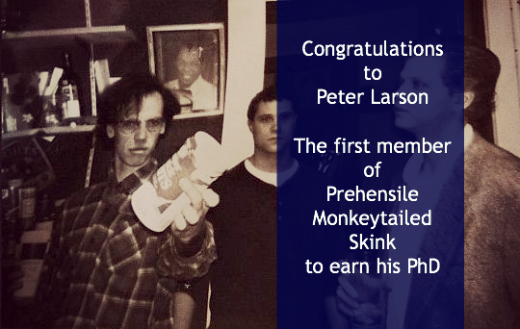
 One more thing… I don’t know if Pete will pursue it, but he and I have been kicking around an idea which we think may cut down on the spread of malaria in Africa. The idea arose out of a conversation that we had over lunch a few weeks ago, upon his return form doing field research in Kenya on the use of insecticide treated bed nets. During the course of our conversation, Pete mentioned that, according to his research, a surprisingly large percentage of people don’t use bed nets because they feel as though malaria is spread by way of witchcraft, rather than by mosquito. Well, upon hearing that, it occurred to me that, if you could convince people that bed nets actually served as barriers to witchcraft, that the end result could be increased usage, and decreased instances of malaria. As I scientist, I don’t know that he so much liked the idea of playing upon superstitions, and marketing something as “witch-proof,” but he conceded that it might be a test worth running. And, from there, we began talking about other possibilities, such as imprinting the nets, which are given away freely by a number of non-profits doing work in the country, with images of famous football players, revered spiritual figures, and musicians like Bob Marley, who, according to Pete, still has quite the following in Africa. At any rate, Pete and I pitched the idea on Friday night, over coffee, to a the director of a Japanese research group doing work in Africa. I suspect it’s highly unlikely that we’ll get any traction with it, but, as I very much like the idea, I thought that it was worth mentioning here… just in case anyone from the Gates Foundation might be reading.
One more thing… I don’t know if Pete will pursue it, but he and I have been kicking around an idea which we think may cut down on the spread of malaria in Africa. The idea arose out of a conversation that we had over lunch a few weeks ago, upon his return form doing field research in Kenya on the use of insecticide treated bed nets. During the course of our conversation, Pete mentioned that, according to his research, a surprisingly large percentage of people don’t use bed nets because they feel as though malaria is spread by way of witchcraft, rather than by mosquito. Well, upon hearing that, it occurred to me that, if you could convince people that bed nets actually served as barriers to witchcraft, that the end result could be increased usage, and decreased instances of malaria. As I scientist, I don’t know that he so much liked the idea of playing upon superstitions, and marketing something as “witch-proof,” but he conceded that it might be a test worth running. And, from there, we began talking about other possibilities, such as imprinting the nets, which are given away freely by a number of non-profits doing work in the country, with images of famous football players, revered spiritual figures, and musicians like Bob Marley, who, according to Pete, still has quite the following in Africa. At any rate, Pete and I pitched the idea on Friday night, over coffee, to a the director of a Japanese research group doing work in Africa. I suspect it’s highly unlikely that we’ll get any traction with it, but, as I very much like the idea, I thought that it was worth mentioning here… just in case anyone from the Gates Foundation might be reading. 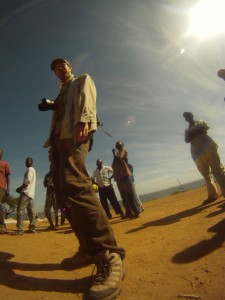 Those interested in getting to know Doctor Larson better are encouraged to check out
Those interested in getting to know Doctor Larson better are encouraged to check out 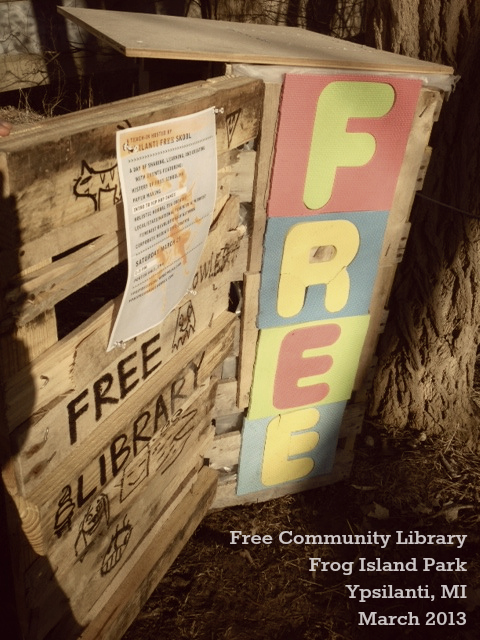
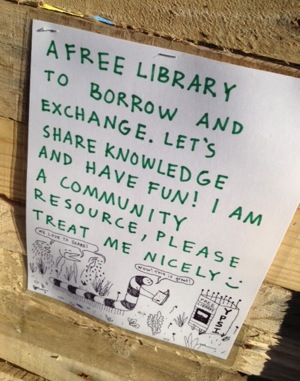 These, in my opinion, are the kinds of things we need more of in this community… little reminders of the fact that we exist in a community of bright people looking for opportunities to share with one another, and make the world a little bit better place. Because I’d been reading through the comments following
These, in my opinion, are the kinds of things we need more of in this community… little reminders of the fact that we exist in a community of bright people looking for opportunities to share with one another, and make the world a little bit better place. Because I’d been reading through the comments following 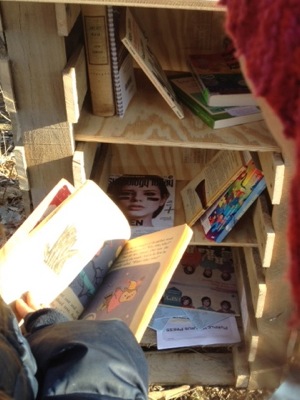 As for the scrappy, little DIY movement that’s taking root in Ypsi, tomorrow there’s going to be an opportunity for you to see it firsthand. Between 1:00 and 5:00, at EMU’s
As for the scrappy, little DIY movement that’s taking root in Ypsi, tomorrow there’s going to be an opportunity for you to see it firsthand. Between 1:00 and 5:00, at EMU’s 

 MARK: I understand wanting to follow your girlfriend, and put some distance between you and your conservative parents, but I’m having a little more trouble with the Chomsky argument. Not many people come to America to escape the things that he speaks of in Manufactured Consent.
MARK: I understand wanting to follow your girlfriend, and put some distance between you and your conservative parents, but I’m having a little more trouble with the Chomsky argument. Not many people come to America to escape the things that he speaks of in Manufactured Consent. MARK: You mention being an undocumented worker. I assume that makes life challenging. Could you perhaps speak a bit about how your life might be different from other readers of this site as a result of that, and what resources exist for people like you that are walking the line of legality. (I’m curious, for instance, if people in similar situations find one another, share information, etc.) And is legal residency something that you’d consider?
MARK: You mention being an undocumented worker. I assume that makes life challenging. Could you perhaps speak a bit about how your life might be different from other readers of this site as a result of that, and what resources exist for people like you that are walking the line of legality. (I’m curious, for instance, if people in similar situations find one another, share information, etc.) And is legal residency something that you’d consider? I ended up joining the “
I ended up joining the “









